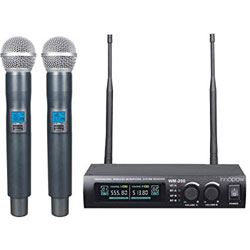1. Excellent sound quality
Digital wireless microphone systems provide high quality transparent audio. This is largely due to the fact that traditional wireless microphones do not have a "compression expander", a circuit that reduces noise and maximizes dynamic range for all analog wireless microphone systems
. Audio signals are compressed through transmitters to accommodate the limited dynamic range during FM transmission, and then expanded in receivers.
Compression and expansion of this process, although relatively small in most excellent analog systems, there will still be some artificially audible sounds (such as the wheezing effect) that will make the voice of wireless microphones slightly different from that of wired microphones. Since the use of digital wireless microphone systems, the transmission of audio signals no longer requires compression and expansion, and the received signals restore the precise characteristics of the original audio.
2. Compression expander (variable)
A digital wireless microphone can achieve the entire audible audio range with a flat frequency response curve.
Digital wireless microphones convert analog audio into digital signals by modulating radio carriers in several steps. The digital audio signal arrives at the receiver without the influence of electromagnetic noise. Any RF noise below the threshold does not affect audio quality. The receiver simply ignores anything that is not 1 or 0. Everything else was discarded. Only digital signals can be identified.
3. Longer battery life
Generally, digital wireless microphone systems have a 30% to 40% longer battery life than the same analog systems. Some of our new digital wireless microphone systems use rechargeable lithium-ion batteries, which can run for at least 8 hours under normal operation.
4. Better spectral efficiency
By allowing tighter channel spacing, digital wireless microphone systems
can use more effective compatible frequencies at the same time in a certain frequency band. This feature is particularly important in the increasingly crowded UHF TV bands operated by many wireless microphones
. With manufacturers and models, digital wireless microphone systems
can usually deliver twice as many frequencies as analog wireless systems can use.
Digital wireless microphone has changed the traditional wireless microphone and brought profound changes. It is believed that with the further development and integration of modern communication technology and computer technology, it will penetrate into all areas of social life and play an increasingly important role.





 【DSPPA Demo】PAVA8000 EN54 Voice Evacuation SystemNovember 12, 2020Abstract: DSPPA PAVA8000 EN54 Voice Evacuation SystemToday, we are gonna show you a demo about our PAVA8000 EN54 Voice Evacuation System.PAVA8000EN54 Voice Evacuation System can not only support manua...view
【DSPPA Demo】PAVA8000 EN54 Voice Evacuation SystemNovember 12, 2020Abstract: DSPPA PAVA8000 EN54 Voice Evacuation SystemToday, we are gonna show you a demo about our PAVA8000 EN54 Voice Evacuation System.PAVA8000EN54 Voice Evacuation System can not only support manua...view The National Standard Approval Meeting held in BeijingJuly 19, 2019The National Standard Approval Meeting held in BeijingThe approval meeting of the National StandardTechnical standard of public address system engineeringis held in Beijing on July 16, 2019. Xue Chang...view
The National Standard Approval Meeting held in BeijingJuly 19, 2019The National Standard Approval Meeting held in BeijingThe approval meeting of the National StandardTechnical standard of public address system engineeringis held in Beijing on July 16, 2019. Xue Chang...view


